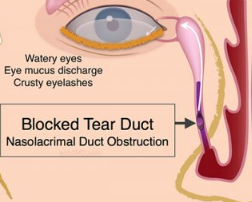When it comes to congenital eye conditions, one of the commonly encountered issues is congenital nasolacrimal duct obstruction (CNLDO). CNLDO refers to a blockage or obstruction in the nasolacrimal duct which is responsible for draining tears from the eye to the nose.
What Causes Congenital Nasolacrimal Duct Obstruction?
CNLDO occurs in infants when the nasolacrimal duct fails to develop properly or becomes blocked. The exact cause of CNLDO is not always clear but it is believed to result from a combination of factors including:
- Anatomical abnormalities: Some infants may be born with a narrow or underdeveloped nasolacrimal duct making them more prone to obstructions.
- Membrane blockage: In some cases, a thin membrane can obstruct the nasolacrimal duct preventing tears from draining properly.
- Infection or inflammation: Infections or inflammation in the area surrounding the nasolacrimal duct can lead to blockages and subsequent symptoms.
Symptoms of CNLDO
Infants with CNLDO may exhibit several signs including:
- Excessive tearing: The most common symptom of CNLDO is excessive tearing or watering of the affected eye.
- Crusting or matting: Due to the accumulation of tears the affected eye may appear crusty or matted upon waking up.
- Redness or swelling: In some cases, the eye may become red or swollen due to the blocked tear drainage.
- Recurrent eye infections: If the tears cannot drain properly it creates a breeding ground for bacteria, leading to recurring eye infections.

Diagnosing Congenital Nasolacrimal Duct Obstruction
When a child presents with symptoms suggestive of CNLDO a comprehensive evaluation is necessary to confirm the diagnosis. Ophthalmologists and pediatricians often employ the following methods for diagnosis:
- Medical history: Gathering information about the child’s symptoms and medical history can provide valuable insights.
- Physical examination: A thorough examination of the eyes, eyelids and tear drainage system is conducted to identify any physical abnormalities.
- Dye disappearance test: A specialized dye is used to evaluate tear drainage. If the dye takes longer to disappear from the eye it suggests an obstruction in the nasolacrimal duct.
Treatment Options for CNLDO
The management of CNLDO aims to alleviate symptoms, promote proper tear drainage and prevent complications. The treatment options available include both conservative and interventional approaches.
1. Conservative Management
Conservative management is often the first line of treatment and may involve:
- Massage: Gentle massage of the tear duct area can help stimulate tear drainage and improve symptoms.
- Warm Compresses: Applying warm compresses to the affected eye can help alleviate swelling and promote duct opening.
2. Interventional Procedures
If conservative measures fail to provide sufficient relief the following interventional procedures may be considered:
- Probing and Irrigation: This procedure involves passing a thin probe through the tear duct to clear the obstruction and flush the nasolacrimal system.
- Balloon Catheter Dilation: A deflated balloon catheter is inserted into the duct and then inflated to widen the narrow portion and improve tear drainage.
- Intubation: In some cases, a small tube called an intubation stent may be placed in the tear duct to maintain its patency and ensure proper drainage.
Post-Treatment Care and Outlook
Following treatment it is important to provide appropriate post-care instructions to ensure optimal recovery. This may include:
- Administering prescribed eye drops or ointments as directed.
- Practicing good hygiene by keeping the eye area clean and avoiding exposure to irritants.
- Scheduling follow-up appointments to monitor progress and address any concerns.
The prognosis for infants with CNLDO is generally favorable with most cases resolving spontaneously within the first year of life. However, in instances where persistent symptoms or complications arise further intervention or consultation with a specialist may be necessary.
Hence, Congenital Nasolacrimal Duct Obstruction (CNLDO) is a common condition in infants where there is a blockage in the tear drainage system. This blockage occurs when the nasolacrimal duct fails to fully develop during fetal development leading to tear duct obstruction. As a result, tears are unable to drain properly from the eyes causing excessive tearing, discharge and potential eye infections.






